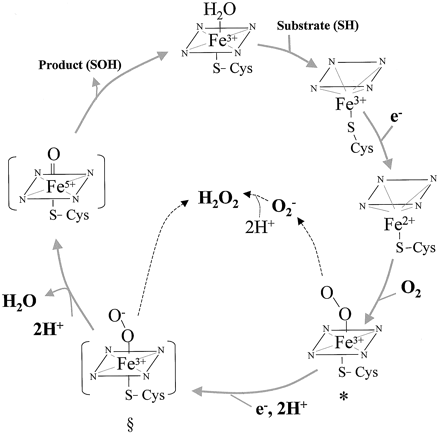CYP3A4
From Proteopedia
| Line 3: | Line 3: | ||
<Structure load='4NY4' size='350' frame='true' align='right' caption='Insert caption here' scene='Insert optional scene name here' /> | <Structure load='4NY4' size='350' frame='true' align='right' caption='Insert caption here' scene='Insert optional scene name here' /> | ||
| - | Cytochrome P450 3A4 (CYP3A4) is in the heme-thiolate monooxygenase enzyme family meaning the protein contains a heme group with an iron atom. Enzymes in Cytochrome P450 are oxidizing enzymes and CYP3A4 works in the body oxidizing foreign molecules such as toxins and drugs<ref name="Dai">PMID:16389357</ref><ref name=" | + | Cytochrome P450 3A4 (CYP3A4) is in the heme-thiolate monooxygenase enzyme family meaning the protein contains a heme group with an iron atom. Enzymes in Cytochrome P450 are oxidizing enzymes and CYP3A4 works in the body oxidizing foreign molecules such as toxins and drugs<ref name="Dai">PMID:16389357</ref><ref name="b">PMID:15603755</ref>. It appears almost half of the marketed pharmaceutical drugs are metabolized by CYP3A4 [http://www.pharmacytimes.com/publications/issue/2008/2008-09/2008-09-8687] All Cytochrome P450 are essential enzymes for metabolism and the sub family 3A4 is the most important. [http://www.medsafe.govt.nz/profs/PUArticles/March2014DrugMetabolismCytochromeP4503A4.htm] Primarily found in the liver and intestine, CYP3A4 is localized in the endoplasmic reticulum membrane [http://www.uniprot.org/uniprot/P08684] and are present in all eukaryotic organisms as well as some prokaryotes<ref name="Dai">PMID: 15352783</ref>. While CYP3A4's role in drug metabolism are numerous, they are often aiding deactivation through facilitated excretion from the system or by direct inactivation. [https://en.wikipedia.org/wiki/CYP3A4#Tissue_distribution] |
Revision as of 21:06, 11 May 2016
Contents |
Overview
|
Cytochrome P450 3A4 (CYP3A4) is in the heme-thiolate monooxygenase enzyme family meaning the protein contains a heme group with an iron atom. Enzymes in Cytochrome P450 are oxidizing enzymes and CYP3A4 works in the body oxidizing foreign molecules such as toxins and drugs[1][2]. It appears almost half of the marketed pharmaceutical drugs are metabolized by CYP3A4 [1] All Cytochrome P450 are essential enzymes for metabolism and the sub family 3A4 is the most important. [2] Primarily found in the liver and intestine, CYP3A4 is localized in the endoplasmic reticulum membrane [3] and are present in all eukaryotic organisms as well as some prokaryotes[1]. While CYP3A4's role in drug metabolism are numerous, they are often aiding deactivation through facilitated excretion from the system or by direct inactivation. [4]
Mechanism
Because water molecules are stripped away when the substrate binds, this causes an entropy change of 26 kcal/mol. This entropy driven reaction has a spontaneous free energy change of -7.7 at 21ºC [1]. The cycle begins with the binding of the substrate to the ferric heme. With the addition of an electron, the heme gets reduced. This can only happen once the substrate is bound because the reduction potential is -300V while in that state and is more electronegative. After substrate binding, the induced conformational shift causes the reduction potential to be more positive at -230V making this a more thermodynamically favorable reaction. Oxygen next binds to the heme and oxidizes it. The addition of a second electron cleaves the oxygen-oxygen bond allowing one atom to bind two hydrogens producing water and the second oxygen joins the substrate in what is called a monoxygenation reaction [3] .
Structure and Sequence
The gene encoding CYP3A4 is located on chromosome 7 in the human genome[1] and it is found that there is a significant finding in variants of the protein correlating to race [1]. This finding is relevant due to the proteins altered ability to react with substrates such as testosterone [1].
The metal-binding site, the protein pocket where the reactions are catalyzed, are found in the seqence at position 442-442 [5].
|
The contains Cysteine 442, which coordinates with iron.
Mutations/Defects
External Sources
Mechanism of Oxidation Reactions Catalyzed by Cytochrome P450 Enzymes [6]
- ↑ 1.0 1.1 1.2 1.3 1.4 1.5 Ogu CC, Maxa JL. Drug interactions due to cytochrome P450. Proc (Bayl Univ Med Cent). 2000 Oct;13(4):421-3. PMID:16389357
- ↑ Gonzalez FJ. Role of cytochromes P450 in chemical toxicity and oxidative stress: studies with CYP2E1. Mutat Res. 2005 Jan 6;569(1-2):101-10. PMID:15603755 doi:http://dx.doi.org/10.1016/j.mrfmmm.2004.04.021
- ↑ Devlin, Thomas M., ed. Textbook of Biochemistry with Clinical Correlations. 6th ed. Hoboken: John Wiley, 2006. Print.

